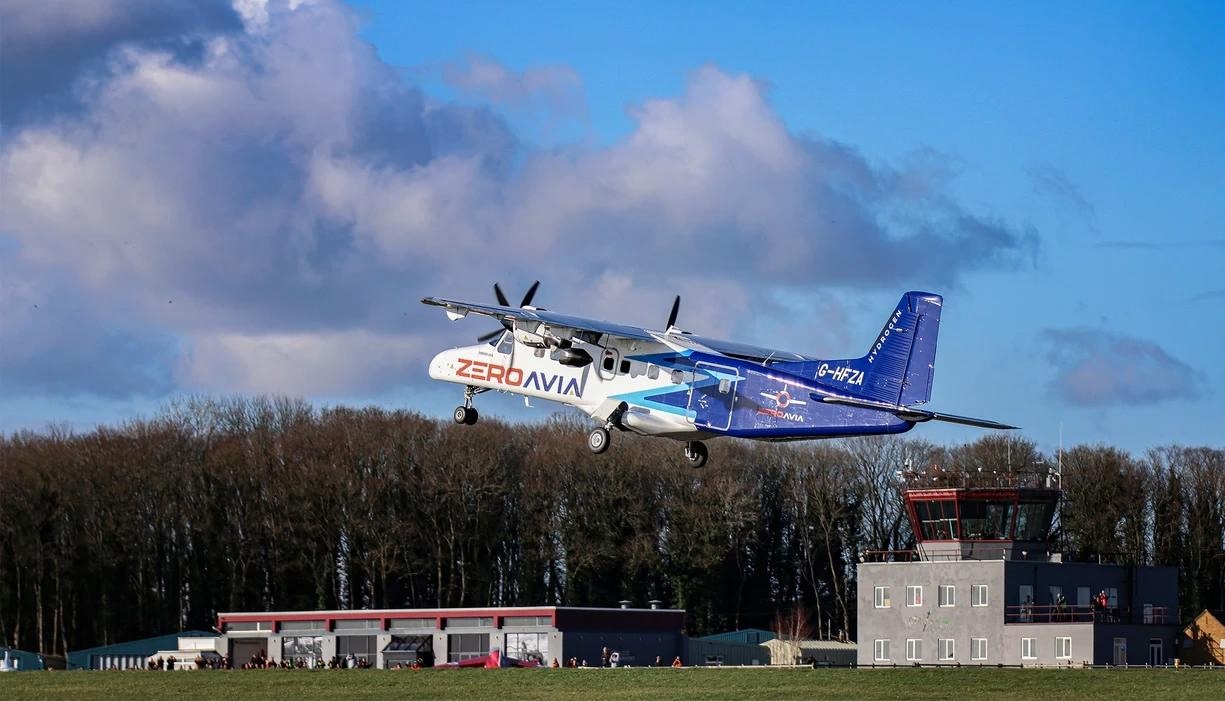Aviation emissions are considered a major contributor to climate change as aircraft typically burn fossil-based fuels, which release large amounts of CO2 into the atmosphere. Moreover, the industry also contributes to non-CO2 warming effects as they release nitrogen oxides (NOx), leave vapor trails and influence cloud formation as a result of flying altitudes.

Image Credit: ZeroAvia
ZeroAvia, a British/American aerospace company founded in 2018, has recently made aviation history by flying a 19-seat Dornier 228 test aircraft powered by a hydrogen-electric engine.
Taking off from the company’s Kemble R&D facility at Cotswold Airport in Gloucestershire, UK, the Dornier 228 was able to taxi, take off, and land after completing a test-flight circle pattern that lasted 10 minutes. This breakthrough takes ZeroAvia one step closer to meeting its target of achieving commercial flight using only hydrogen fuel calls by 2025 and scaling up the technology to fit larger types of aircraft.
Back in 2019, ZeroAvia had already made its mark on aviation history after it put the world’s first zero-emission flight into the sky; a Piper M-Class 6-seater aircraft fitted with its hydrogen-electric powertrain. Having now proved they can fly a larger aircraft with the same zero-emissions technology, the ZeroAvia team has demonstrated that the hydrogen-electric technology can be scaled up.
The first flight of our 19-seat aircraft shows just how scalable our technology is and highlights the rapid progress of zero-emission propulsion. This is only the beginning – we are building the future of sustainable, zero climate impact aviation.
Val Miftakhov, Founder & CEO of ZeroAvia
Hydrogen-Electric Powertrain
ZeroAvia claims that hydrogen-electric powertrains possess 30 times more specific energy and lower cycling when compared to lithium-ion batteries. The technology holds a series of other advantages over all other alternative decarbonization solutions as a fully scalable zero-emission aviation solution.
The fuel cells in the zero-emission hydrogen-electric powertrains use hydrogen fuel to trigger a chemical reaction which then generates electricity. That electricity is what powers the electric motors to drive the propellers, with water being the only byproduct of the process
ZeroAvia’s hydrogen-electric engine was retrofitted onto the left wing of the Dornier 228, a twin-engine aircraft, while a Honeywell TPE-331 stock engine was left in place on the right wing.
During testing, the hydrogen-electric powertrain contained two fuel cell stacks, with lithium-ion battery packs supplying peak-power support during take-off and adding additional redundancy to ensure a safe testing program.
While the hydrogen tanks and fuel cell power generation systems were stored inside the cabin during the tests, commercial flights would require external storage in order to carry passengers inside the craft.
HyFlyer II and HARE
The latest breakthrough in hydrogen-electric aviation comes under the remit of the R&D HyFlyer II project, a program that the UK Government’s ATI Program supports. ZeroAvia’s goal with HyFlyer II is to develop a 600 kW powertrain to achieve commercial zero-emission flight globally using 9-19 seat aircraft.
To fuel the hydrogen-electric powertrain onboard the 19-seat Dornier 228 aircraft, an on-site electrolyzer was used to produce compressed gaseous hydrogen. In order to facilitate on-site hydrogen production, ZeroAvia, in partnership with its HyFlyer II associate, the European Marine Energy Centre (EMEC), developed the Hydrogen Airport Refuelling Ecosystem (HARE).
The HARE infrastructure provides insight into what on-site green hydrogen production, storage, refueling and fuel-cell-powered flight could look like in the future. Moreover, ZeroAvia and EMEC demonstrated the ability to double the system’s electrolyzer capacity for the latest project.
This is only the beginning – we are building the future of sustainable, zero climate impact aviation.
Val Miftakhov, Founder & CEO of ZeroAvia
Making History
Moving forward, ZeroAvia will continue to develop and scale its hydrogen-electric powertrains towards a certifiable configuration that could see zero-emission commercial routes taking to the skies as early as 2025.
Under the HyFlyer II project, the Dornier 228 will continue to take a number of test flights from the R&D facility at Cotswold Airport and later go on to take test flights from other airports.
Having put another world’s first feather in its cap, ZeroAvia continues to make history and build some serious momentum towards commercial success with 1,500 engines already on pre-order and landing partnerships with seven aircraft manufacturers.
The company has also managed to secure an engine order from American Airlines and lock in infrastructure partnerships with a number of international airports, including Rotterdam, Edmonton International, and AGS Airport.
ZeroAvia leads the way as it sets off on a new trajectory to secure the aviation industry’s transition to a cleaner future.
References and Further Reading
Aviation history: Hyflyer II programme First Flight: Hydrogen powered dornier 228: Hydrogen-electric engine (2023) ZeroAvia. Available at: https://www.zeroavia.com/do228-first-flight
EMEC: European Marine Energy Centre (2023) EMEC European Marine Energy Centre. Available at: https://www.emec.org.uk/projects/hydrogen-projects/hyflyer
Disclaimer: The views expressed here are those of the author expressed in their private capacity and do not necessarily represent the views of AZoM.com Limited T/A AZoNetwork the owner and operator of this website. This disclaimer forms part of the Terms and conditions of use of this website.